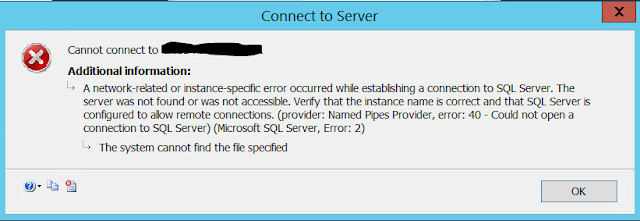A network-related or instance-specific error occurred while establishing a connection to SQL Server. The server was not found or was not accessible. Error 40
Hi there.
This post will use SSMS (SQL Server Management Studio) as well as Redgate SQL Clone.
At the time I am writing this, the latest version of SQL Clone is 4.0.2.19054.
SQL clone is an application that lets you create a copy of an original database (clone) from an image (master file) that you create.
This technology comes in handy because:
Now it's time for the meat an potatoes.
I received an alert that my SQL Clone process failed and no clones were generated :( .
Here's the specific error:
Error while opening connection to the SQL server ServerName: A network-related or instance-specific error occurred while establishing a connection to SQL Server. The server was not found or was not accessible. Verify that the instance name is correct and that SQL Server is configured to allow remote connections. (provider: Named Pipes Provider, error: 40 - Could not open a connection to SQL Server) (SqlServerConnectionException)
Here's how I fixed the issue:
Thank you and Happy reading,
-marshé hutchinson
#learnSQLwithme
This post will use SSMS (SQL Server Management Studio) as well as Redgate SQL Clone.
At the time I am writing this, the latest version of SQL Clone is 4.0.2.19054.
SQL clone is an application that lets you create a copy of an original database (clone) from an image (master file) that you create.
This technology comes in handy because:
- Developers can test against the clone without altering the original database.
- The clone is much smaller in size and consumes less storage resources.
- Once you make an image of a database, you can clone the image to multiple servers. Clones work independently from the image.
- You can also enforce security by granting/restricting permissions to active directory groups or individuals.
Now it's time for the meat an potatoes.
I received an alert that my SQL Clone process failed and no clones were generated :( .
Here's the specific error:
Error while opening connection to the SQL server ServerName: A network-related or instance-specific error occurred while establishing a connection to SQL Server. The server was not found or was not accessible. Verify that the instance name is correct and that SQL Server is configured to allow remote connections. (provider: Named Pipes Provider, error: 40 - Could not open a connection to SQL Server) (SqlServerConnectionException)
Here's how I fixed the issue:
- I logged in to the server with the issue and tried to connect to the SQL instance. I was not able to get into the instance.
- I tried to connect to the configuration manager to investigate further and received this error:
Cannot connect to WMI provider. You do not have permissions or the server is unreachable. Note that you can only manage SQL Server 2005 and later servers with SQL Server Configuration Manager. Invalid class [0x80041010] - I checked the services for the SQL instance. It turns out that even though the service StartupType is automatic, the service was not running. I tried to start the service and received this error:
Windows could not start the SQL Server (MSSQLSERVER) service on the local computer. Error 1069: The service did not start due to a login failure.
I updated the account that was being used to start the SQL service with an administrator account (database engine) account.
This resolved the issue. You're all set!
If you have any further questions, please post below.
Thank you and Happy reading,
-marshé hutchinson
#learnSQLwithme

Comments
Post a Comment